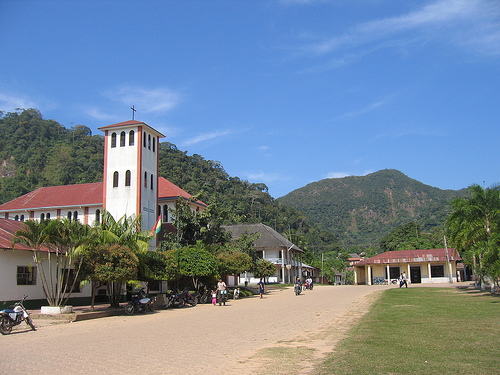

Location: Beni Department Map
Rurrenabaque is a small town located on the banks of Beni river in Beni Department in Bolivia. The easiest way to get here is by plane. Three airlines that offer flights here are Aerocon, Amaszonas and Transporte Aereo Militar (TAM).
Rurrenabaque before the arrival of the Spaniards, it was
inhabited by Arawak jungle and ethnic peoples, such as the Tacanas
and Araones who grouped numerously to confront the highland
villages, who entered into that region to exchange products such as
feathers and leather for his clothes, wood and medicinal plants.
From 1560, Jesuit, Carmelite and Franciscan religious enter the
region to evangelize along with civilians and military with the aim
of settling down, finding a climate and a very adverse region,
facing the original settlers who attacked them defending their
territory that They were invaded.
The missionary activity
brought about changes in the social and productive organization of
the indigenous peoples. The new religious concepts were mixed with
local beliefs, leading to religious syncretism. The introduction of
cattle created a new productive dynamic, based on agriculture,
livestock and the extraction of natural resources. The missions
became food supply centers, which were marketed with other regions.
Rurrenabaque, in 1810, was a small village and resting port
where travelers from the Mocetenes and Apolobamba region were
rescuers of the quina shell, which became a very important medicinal
product of exploitation, in the middle of the 19th century.
Father Giovani Gianelli is mentioned as founder of Rurrenabaque, on
February 2, when the Virgin of the Candelaria is celebrated, as
Patroness of the town, with the name of La Cruz; as there is no
documentation on the date of foundation until then, it was the
tradition of commemorating this holiday every February 2.
The
date documented as the foundation of Rurrenabaque is November 15,
1844, which is recorded in Decree Law of November 17, 1844, issued
by President Gral. José Ballivián, which cites
"... change
the name of Rurrenabaque to that of Ciudad Ballivián and become the
capital of the new department of Beni."
However, this decree
was not fulfilled for various reasons, such as the lack of
communication between peoples.
The rubber boom, by the year
1880, accelerated a process of colonization and economic movement,
being Rurrenabaque, an important shipping port for rubber
production, food and mass transport of labor for barracks and
rubber, and transit unavoidable boats from La Paz, heading to the
rubber and chestnut centers. At the end of this boom, migrants from
other countries settled in Rurrenabaque, attracted by the economic
flourishing, the rubber trade, the quina and then the gold.
Since 1995, Rurrenabaque is the capital and municipal government of
the 4th. Section of the province Gral. José Ballivián, and today,
continues to be a knot of transport, commerce and production, added
to the flourishing activity of productive tourism.
Its
cultural manifestations recalled the ancient traditions of the
Tacanas groups in terms of dances, clothing and customs, which with
fermented chicha and hunting meals, extended for several days.
On the day of the town festival, the main activity was to
commemorate the Mamita de la Candelaria, who received the visit of
all the people who, in pilgrimage, came to her altar to express
gratitude for the blessings received.
With the passing of the
years, the customs were changing and new groups were formed, with
new dances, instruments and clothing during the festivity of the
population; emerging thus, the puli pulis, macheteros, callahuayas,
zampoñeros and the breasts, which accompanied the "procession" of
the Blessed Virgin of the Candelaria, Patroness of the town, whose
image was carried by the few streets culminating with the Holy Mass,
as a reason for greeting and blessing to its 1500 inhabitants.
Afterwards, the jocking of bulls, the race of horses, of "ring", of
callapos and canoes, motivating the presence of all the inhabitants
was carried out.
Movie The Shed
"La Vertiente" is the first sound feature in
the history of Bolivian cinema, made in 1958 by Jorge Ruiz, who
filmed the entire process and development, of a local-rural project
for the capture of water from a slope, having participated in the
film more than two thousand inhabitants of the town of Rurrenabaque
located on the banks of the Beni River; a whole spontaneous mass
movement, which at the orders of the director acquires enough
dramatic power to move the viewer; power that resides in the
feelings of men and women, even children who appear on the screen in
a scenic mind, artistic manifestation.
The lack of
leadership, indifference, the collective citizen abulia that is
waiting for the solution to their basic problems such as drinking
water, come from the central government or the departmental, local
authorities, etc., has existed and exists in many communities; This
motivated Oscar Soria Gamarra, to write a script that, in parallel
to the filming of the construction of the aqueduct, tells a
not-so-fiction story, that of a school teacher who, having lived
through the tragedy of the death of one of his students, assumes the
challenge of organizing them to carry out the work of a water
catchment, with only their will and the indifference of the
residents of the town.
"La Vertiente", is an important
historical document, in which a skilled and determined team achieves
approaches, frames, planes of great originality. Another important
element is the film's soundtrack, the Anthem to work written
especially for the film by Argentine composer Tito Ribero, a musical
score that brilliantly sustains the action until the end. The
success obtained, both in Bolivia and internationally, is attributed
indistinctly to the universal interest of the central theme:
communalism, as a form of social development, and the quality of the
drama itself; the living conditions of communities far from the
great urban centers that Jorge Ruiz once knew how to assimilate with
imagination and moral honesty. The educational film was spread in
many countries of Asia, Africa and Latin America, made in 35 mm.,
Lasts 60 minutes.